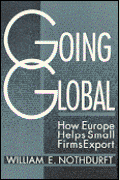The day U.S. Commerce Secretary Penny Pritzker announced the Obama administration’s new plan for exports, leaders from over a dozen metropolitan areas were gathering in Phoenix to talk about how to grow their economies through more trade and global engagement.
As one leader from San Diego observed: Just because we’re located on the border, doesn’t make us global. Indeed, even though San Diego considers itself a bi-national region, only 11.5 percent of its economic output comes from exports, ranking it 55th among the largest 100 metro areas.
This is why the continued national focus on exports, dubbed NEI/Next, is welcome. Despite record levels of exports and exporting firms, the United States has more work to do to be more global. Just 13 percent of national economic output comes from exports, compared to much larger shares among our trade partners (even Canada, with its large interior market, has nearly 30 percent of its output driven by international sales). Meanwhile, only 5 percent of American firms with employees sell in foreign markets.
The difficulty of re-orienting the U.S. economy toward global opportunities can be felt on the ground.
The regional leaders gathered in Phoenix shared what they learned from surveying and talking to firms as part of their development of regional export strategies, a commitment they made as participants in the Global Cities Initiative a joint project of Brookings and JPMorgan Chase. Consistently, they heard the following:
Their companies don’t believe their product or service can be exported. Executives don’t believe this is the time to take risks. They can’t access capital. They don’t know how to get started. And the vast majority of firms, non-exporters and exporters alike, don’t know that services and programs exist to help them navigate the export process.
Meanwhile, local economic development leaders themselves are trying to break from traditional approaches. Job growth strategies such as firm chasing, real estate transactions, and retail development further reinforce reliance on domestic consumption.
Yet, these regional leaders understand the promise of greater global engagement. Firms that did export were emphatic that going global was an imperative if they were to survive. Those firms that did use federal and state trade services, like the Commerce Department’s Gold Key Matching Service, rated them highly. And regional leaders recognize that the rapidly evolving and expanding global marketplace demands that they pivot toward strategies that maximize their region’s competitive advantages in discrete sets of tradable products and capabilities.
The regional plans underway reflect the twin goal of boosting near term exports while also increasing global fluency. Portland is enhancing the competitiveness of its largest export industry, computers and electronics, by improving regional freight movement and facilitating global supply chain connections for firms like Intel and Tektronix. San Diego is targeting improvements in its cyber infrastructure to support its highly innovative telecom and biotech firms, which increasingly rely on global data flows to produce and deliver advanced services. Minneapolis-Saint Paul converted a fragmented set of export services into a streamlined portfolio to help small companies take the first step towards exporting or enter new markets.
These are the early signs that a culture shift is underway, with firms and regions across the country finally looking outward for growth. The continued national commitment to boosting exports and foreign investment, through NEI/Next, will further the United States’ embrace of global engagement as a fundamental part of economic growth and global success.











Commentary
What’s Next for U.S. Exports?
May 21, 2014